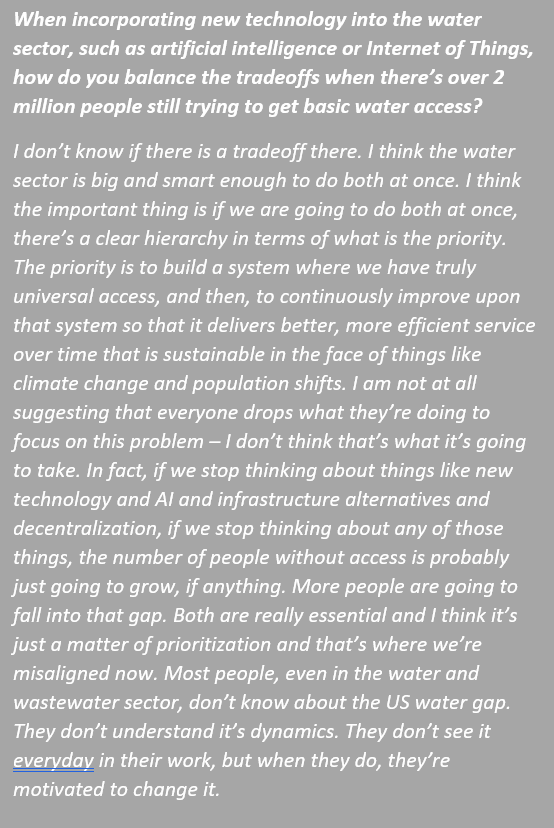Many of us in the United States have come to expect clean running water and indoor plumping. While this convenience is often viewed as universal, over 2 million Americans today still do not share that luxury. Though analysis of water access inequity often focuses overseas, DigDeep and founder George McGraw quickly realized the problem occurs in our own backyard.
DigDeep is a human rights-based nonprofit working to improve clean and safe water and sanitation access in the United States through advocacy, research, and community-led work. While their work began in East and West Africa, founder George McGraw switched his efforts in response to the largely invisible water crisis in the United States. “We didn’t start in the U.S.,” George said. “We started abroad, then only several years later we were introduced to the size and scope of the problem in our own backyards. It really turned our attention here at home.”
Closing the Water Access Gap in the United States
Seeking to change the narrative and increase visibility of water access struggles in the U.S., DigDeep and the U.S. Water Alliance released the “Closing the Water Access Gap in the United States” report in 2019, representing the most comprehensive water and sanitation access analysis in the United States to date. Using quantitative data analysis and on-the-ground exploration of six U.S. regions experiencing water access challenges, the report put forward an action plan to spark water equity efforts in the United States.
The report reveals that more than 2 million Americans live without basic access to safe water and sanitation, including 1.4 million without access to indoor plumbing, 553,000 people who are homeless, and 250,000 in Puerto Rico. It also highlights major racial divides when it comes to water and sanitation access. “Race is the strongest indicator of whether or not you and your family will have a working tap or a toilet in your house. If you’re indigenous, you’re 19 more times more likely than a white family to not have running water. If you’re black or Latino, you’re twice as likely,” said George.
Though water access struggles in the U.S. may seem like isolated events, the report reveals that inadequate water and sanitation infrastructure negatively impacts entire communities. On the Navajo Nation, some residents have to drive up to 40 miles to collect water. In fact, the report estimates approximately 30 percent of residents do not have access to running water. Inadequate water supplies lead to a plethora of challenges, including additional stress on already strained budgets, inadequate hygiene, hindered food preparation and high rates of diabetes as sugary beverages are more accessible than clean water.
While similar cases exist all across the U.S., many are still under the impression that everyone has adequate clean water and sanitation access. “That’s the misconception we spend most of our time fighting against,” George said. “Just the invisibility of these communities and how little support they have because they’re not seen, and they’re not understood.”
What We Can Do About It
As some regions in the U.S. work to improve water and sanitation access, many others are backsliding, and progress is uneven. While the issue may seem overwhelming, DigDeep and the U.S. Water Alliance have laid out several action items based on their research.
First, they suggest that the solution should be defined and reimagined. Those affected by water access challenges are often invisible. Their struggles need to be seen and understood, and the public emergency they are facing needs to be defined. Challenging site conditions in many of these communities often make traditional infrastructure options nonviable, but technological innovation and temporary mitigation measures can help fill those gaps.
Next, the report asks us to look at the way resources are distributed. Traditions of financial self-sufficiency for water and wastewater systems puts those with water access challenges at a structural disadvantage. They require additional funding to support maintenance and operations. Nonprofits and the private sector can also alleviate this issue through technical assistance and innovative funding sources.
To ensure solutions remain equitable, DigDeep believes leadership should remain in the communities that experienced the most impacts. “All of our project managers and directors are from the communities in places that they serve. It’s really community-directed work that DigDeep just kind of facilitates. That’s something I’m really proud of – how deep our connections to communities go and how community really leads all of our work and really owns the impact, the pride and the improvements to daily life that come with that,” George said.
What Water Professionals Should Understand about Water Equity
“The thing I want water industry professionals to understand is that there is an equity component to this at all. Most of my colleagues in the industry are so focused on the technical side of the work, and so fascinated by the sort of intricacies of getting this to people, that sometimes it’s hard to pull back and look at the way the system operates wholesale and understand that there are winners and there are losers,” George said. “My advice would be that the beauty of our work [as water professionals] is that it’s not something you experience in 2022 on a computer or in an office. It touches the real lives of people in a very intimate and very daily way. Do everything you can in the beginning of your career to connect with those folks to get in those communities and see how your system is actually impacting people’s lives, because the more you do that, not only the more you will be motivated to do good work, but the more rewarded you will be about the incredible impact you’re having on people’s lives.”

